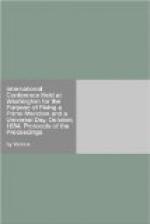The topographical maps may maintain temporarily their national meridian, in consequence of the difficulties of the modification of the co-ordinates for plates already engraved; but it would be necessary to mark on every sheet the difference between the national and the initial universal meridian in degrees of longitude.
It would be most desirable to have in all new geographical catalogues of astronomical and geodetical points the longitudes given in degrees as well as in time, and that in these new catalogues the new initial meridian be taken as the starting point for the longitudes.
The PRESIDENT. The Chair has listened with great interest and pleasure to the paper which has just been read by the Delegate of Russia, Mr. DE STRUVE, but the Chair begs to state that there is no resolution before the Conference.
The PRESIDENT. The Chair will now direct the second resolution to be read.
The resolution was read, as follows:
“From this meridian” (i.e., the meridian passing through the centre of the transit instrument at the Observatory at Greenwich) “longitude shall be counted in two directions up to 180 degrees, east longitude being plus and west longitude minus.”
Mr. RUTHERFURD, Delegate of the United States. Mr. President, In submitting this resolution to the Conference, I wish to say that the remarks of the Delegate of Russia have increased my confidence in the belief of its propriety.
Mr. W. F. ALLEN, Delegate of the United States. Mr. President, the establishment of a prime meridian has, from the force of circumstances, become of practical importance to certain interests entrusted with vast responsibilities for the safety of life and property. These interests bear an important relation to the commerce of the world, and especially to the internal commerce of an extent of country embracing within its limits about sixty-five degrees of longitude. Exactness of time reckoning is an imperative necessity in the conduct of business.
On November 18, 1883, the several railway companies of the United States and the Dominion of Canada united in the adoption of the mean local times of the seventy-fifth, ninetieth, one hundred and fifth, and one hundred and twentieth meridians, west from Greenwich, as the standards of time for the operation of their roads. The system under which they have since been working has proved satisfactory. They have no desire to make any further change. A large majority of the people in the several sections of the country through which the railways pass have either by mutual consent or special legislation adopted for their local use, for all purposes, the standards of time employed by the adjacent roads. Upon the public and working railway time-tables generally the fact has been published that the trains are run by the time of the seventy-fifth or ninetieth, etc., meridians, as the case may be.




